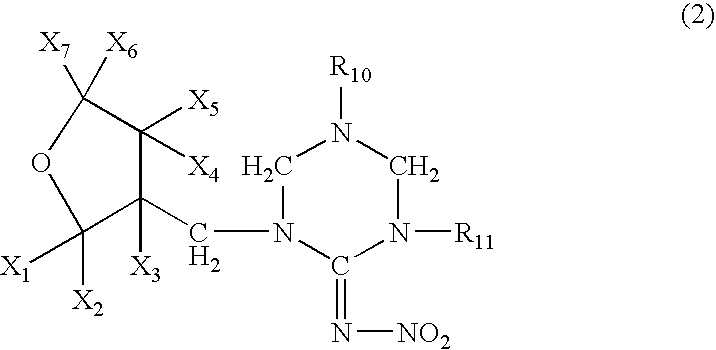High concentration topical insecticide containing insect growth regulator
a technology of growth regulator and insecticide, which is applied in the field of insecticides, can solve the problems of unpleasant smell, high undesirable infestation of fleas in animals, and large mess, and achieve the effect of avoiding many common deleterious side effects and being safe to us
- Summary
- Abstract
- Description
- Claims
- Application Information
AI Technical Summary
Benefits of technology
Problems solved by technology
Method used
Image
Examples
example 1
Preparation of 1-{(tetrahydro-3-furanyl)methyl}-2-nitro-3-methylguanidine (dinotefuran)
[0071] A mixture comprising 10.0 g of (tetrahydro-3-furanyl)methanol, 29.5 g of trifluoromethanesulfonic anhydride, 10.0 g of pyridine and 200 ml of dichloromethane was stirred for an hour at room temperature. Water was poured into the reaction solution to separate the organic layer, which was washed with 1 N hydrochloric acid, water and a saturated saline solution, dried, and concentrated to obtain 20 g of 3-tetrahydro-furanylmethyl triflate. 3.25 g of 60% sodium hydride were added to 12.5 g of 1,5-dimethyl-2-nitroiminohexahydro-1,3,5-triazine and 60 ml of DMF at room temperature, followed by stirring for an hour. 20.0 g of the 3-tetrahydrofuranylmethyl triflate were added thereto, and the mixture was stirred at 50° C. for 2 hours. After cooling the mixture to room temperature, 50 ml of 2N hydrochloric acid were added thereto, followed by stirring at 50° C. for 2 hours. The resultant mixture was...
example 2
Preparation of Insecticide Formulation Containing Dinotefuran, Pyriproxyfen, and Oleyldimethylammonium Chloride
[0072] 0.5 g of oleyldimethylammonium chloride was added to 0.5 g of pyriproxyfen with heat (50 degrees C.) and dissolved. 20.75 g of water followed by 20.75 g of ethyl lactate was then added. 2.1 g of t-octylphenoxzypolyethoxyethanol containing 9 moles of ethlyene oxide (OP 9) was added. 7.8 g of dinotefuran was dissolved in the solution by stirring to produce a clear homogeneous solution followed by cooling to room temperature. The pH was adjusted with sodium carbonate solution to between 5.5 and 7.
example 3
Stability of Dinotefuran / Pyriproxyfen Formulations
[0073] Few solvent systems allow for dinotefuran to remain in solution for one month at low temperatures. Further, solvent systems which allow for high concentrations of dinotefuran to be dissolved do not typically allow for the solubilization of pyriproxyfen. As shown in Table 1, it has been determined that including a quaternary ammonium salt in the solvent allows for an effective amount of pyriproxyfen to become and remain solubilized, thereby producing a stable formulation. The stability of the formulation is based on the criterion of no crystal formation at 0° F. during a 1 month period.
TABLE 1Formulation Stability Studies (% are w / w)SolventQuaternary% Dinotefuran% PyriproxifenSystemAmmonium SaltStable151Water / EthylCetyltrimethylammoniumYesLactate / Ethanolchloride151Water / EthylCetyltrimethylammoniumYesLactatechloride151Water / EthyltallowalkyltrimethylYesLactateammonium chloride151Water / EthyltallowalkyltrimethylYesLactate / Ethano...
PUM
| Property | Measurement | Unit |
|---|---|---|
| temperature | aaaaa | aaaaa |
| temperature | aaaaa | aaaaa |
| temperature | aaaaa | aaaaa |
Abstract
Description
Claims
Application Information
 Login to View More
Login to View More - R&D
- Intellectual Property
- Life Sciences
- Materials
- Tech Scout
- Unparalleled Data Quality
- Higher Quality Content
- 60% Fewer Hallucinations
Browse by: Latest US Patents, China's latest patents, Technical Efficacy Thesaurus, Application Domain, Technology Topic, Popular Technical Reports.
© 2025 PatSnap. All rights reserved.Legal|Privacy policy|Modern Slavery Act Transparency Statement|Sitemap|About US| Contact US: help@patsnap.com


